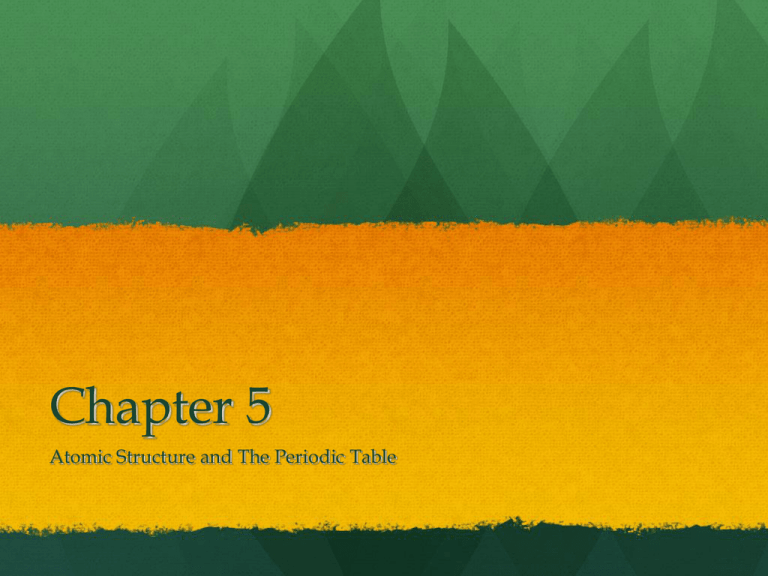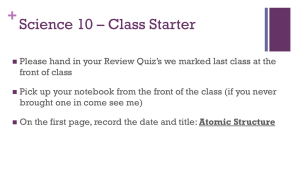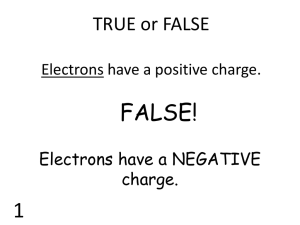Chapter 5 for L3
advertisement

Chapter 5 Atomic Structure and The Periodic Table Objective B: Just how small is an atom? http://imagecache5.art.com/p/LRG/6/667/USYC000Z/fedex-field--washington-d-c-.jpg Has anyone been to a professional football stadium or a major college football stadium? So then, most of the atom is just “empty space.” If the nucleus of an atom was the size of a marble, sitting at the 50 yard line, the electrons would be about the size of really little gnats (bugs) whizzing around the top rows of the upper deck. Angstoms (Å) http://intro.chem.okstate.edu/1314F00/Lecture/Chapter7/ATRADIID.DIR_PICT0003.gif Even the largest atoms are very small. The diameter of a uranium atom is only about 0.345 nanometers. A special unit is sometimes used to describe atomic dimensions, such as atomic radius or atomic diameter. Note the trend as you go across a row and down a column. That is the Angstrom. We use a Å to represent Angstroms (if you want to type that it’s shift-alt-A on a Mac and control-shift-2, shift-A on a bogus, inferior, Windows or Vista based machine). What does an atom look like? http://www.lanl.gov/orgs/pa/newsbulletin/images/Isotopes_logo.jpg In your notes, draw a simple picture of an atom. How about Lithium. What did you draw? AAA baseball club Albuquerque Isotopes logo (you need to know what isotopes are!) Atoms http://upload.wikimedia.org/wikipedia/commons/thumb/e/e1/Stylised_Lithium_Atom.svg/270pxStylised_Lithium_Atom.svg.png http://www.solarsystempictures.net/ Neutron Proton Electron Most people probably drew a nucleus of some type with electrons orbiting around it. Lithium Planets=Electrons Sun=Nucleus Possibly it looks a little like a mini solar system. Atoms are composed of Protons Neutrons Electrons Subatomic Particles: Hint, you need to know this! Particle Relative charge Relative mass Actual Mass of (1 amu = mass of a Particle proton) Proton Neutron +1 1 amu 1.67 x 10-24g 0 1 amu 1.67 x 10-24g -1 0 amu 9.11 x 10-28g Electron Electrons Atoms can gain or lose electrons. Atoms can NEVER gain or lose protons! If an atom loses an electron, it becomes a positive ION. Atoms can lose 1, 2 or 3 electrons If an atom gains an electron, it becomes a negative ion. Atoms can gain 1, 2, or 3 electrons Protons http://www.periodictable.com/Items/020.6/index.html Atomic Number Protons determine the “identity” of an atom. The number of protons is a property called “atomic number.” Atomic numbers are on the periodic table. H has 1 proton C has 6 protons U has 92 protons # Protons = # Electrons Well yes, most of the time. Atoms are NEUTRAL (have the same number of protons and electrons). If the charges don’t balance each other out, then you have an ion. Protons are located in the nucleus of the atom. (Where are the electrons?) Neutrons http://www.ct.infn.it/~rivel/Archivio/chadwick.jpg http://kwisp.files.wordpress.com/2009/05/adventures-jimmy-neutron-300-032707.jpg Neutrons are also located in the nucleus of the atom. Ooops, wrong neutron! The neutron was the last particle discovered, by James Chadwick, a former student of Rutherford. He used paraffin wax to discover neutrons. This was done in 1932. Atoms can have different numbers of neutrons. These are called ISOTOPES. Chadwick The Nucleus http://www.chemicalelements.com/bohr/b0019.gif Since the neutrons are located in the nucleus, with the protons, substantially ALL of the mass of the atom is contained within the nucleus. Mass of nucleus in diagram 0.0000000000000000000000651 g Mass of electrons 0.0000000000000000000000000173 g What element is this?? In other words, if the nucleus weighed 651 pounds, the electrons (combined) would weigh less than a McD’s quarter-pounder patty. Models of the Atom http://www.fiu.edu/~zhangj/cartoon_quantum3.gif Scientists, starting with Dalton, came up with models of the atom, to help understand it and help to predict its behavior. Solid Sphere Model Plum Pudding Model Nuclear Model Planetary Model Quantum Mechanics Do you remember who did each one? Objective E We already know that the number of protons is what makes an atom unique. Hydrogen has 1 proton. Carbon has 6 protons. Uranium has 92 protons. So, if “ProtonMan” The “atomic number” is the number of was a superhero, protons. We sometimes use a Z to he’d have a “Z” on represent atomic number. his suit?? Objective E So, for hydrogen, Z = 1 Don’t memorize these…they are on the Periodic Table For carbon, Z = 6 For uranium, Z = 92. What is the atomic number for Aluminum Zinc Chlorine Find THEM!! Objective F So, Z (atomic number) tells us how many protons an atom has. It does NOT tell you how many ELECTRONS you have (accurately) all the time! Unless you are TOLD that the atom has a charge, you should assume it has no charge, and therefore, # of protons = # of electrons. The number of protons cannot change. If the number of protons changes, it’s no longer the same element. Atoms can gain or lose electrons, but they can NOT gain or lose protons in any chemical reaction. Schwartz’s Law (a law I made up…hey, it’s my class) To calculate the number of electrons, use # of Electrons = Z – IC Where Z = atomic number and IC = ionic charge. Ex: Suppose we have a sodium ion with a + 1 charge. How many electrons does it have? Atomic number (Z) is 11 (find this on Periodic Table) and ionic charge is 1. # electrons = 11 - 1 = 10 Ex: Suppose we have a sulfur ion with a - 2 charge. How many electrons does it have? Atomic number (Z) is 16 and ionic charge is -2. # electrons = 16 - (-2) = 16 + 2 = 18 6 neutrons Objective F http://www.atomicarchive.com/Physics/Images/isotopes.jpg 8 neutrons How do we calculate how many neutrons we have? In order to do that, we need to look at another property, called atomic mass. The atomic mass of an atom = THE SUM of protons and neutrons. We will use another formula Hey these are isotopes again. Isotope = same # of protons but a different # of neutrons. # Neutrons = A – Z A = Mass Number So, what is Z again? Objective F http://www.lbl.gov/abc/Basic.html#Nuclearstructure Let’s look at an example. An atom of Bromine (Br-80) has Z = 35 and Mass Number = 80. How many neutrons does it have? (Br-80 doesn’t mean bromine with a charge of -80. When they write it like that, it’s a DASH and 80 is the mass number) # Neutrons = Mass Number - Atomic Number # Neutrons = 80 - 35 = 45 Objective G http://www.usagold.com/images/gold-coins-images.jpeg http://finestimaginary.com/shop/images/medium/jewellery/au_MED.jpg How do isotopes differ from each other? (You should know this by now). Look at gold (Au) on the periodic table. It says that the mass = 196.967. Since mass number and atomic number are ALWAYS whole numbers, how do we get .967? The answer is that the atomic masses on the periodic table are averages. They get that average atomic mass for Au by taking into account ALL of gold’s isotopes. Isotopes differ from each other in the number of neutrons. They behave the same CHEMICALLY because all isotopes of the same element have the same number of protons. Math Alert Objective H How do we calculate the average atomic mass? To do so, you need to know 2 things: All possible isotopes for an element The percent abundance for each (in other words, how much of the whole is represented by each isotope). Objective H Let’s look at an example: Chlorine has 2 isotopes 35Cl which is 75.77% of the total amount of chlorine. 37Cl which is 24.23% of the total amount of chlorine. What is the average atomic mass of Chlorine? Objective H Cl-35 accounts for 75.77% of the total chlorine. CL-37 accounts for the rest. Remember to convert percents into decimals, you have to move the decimal point 2 places to the left. You then mutiply the percentage (in decimal form) times the mass number for that isotope. You do that for the other isotope too, and then add the answers together. Avg Atomic Mass = 35 (0.7577) + 37 (0.2423). Avg Atomic Mass = 26.52 + 8.97 = 35.49 Objective H In our class, we are always going to round average atomic masses to 1 decimal place. So, we’ll round 35.49 to 35.5 and that’s the average atomic mass of Chlorine that we’ll use. Why can’t you just average 35 and 37 (the two isotopes) and get 36 as the average atomic mass? Why is that wrong? Alkali Metals Sodium and potassium and all the rest of the elements in that group are alkali metals. The alkali metals all have one valence electron. That similarity is what makes them behave the same chemically. They are very reactive. Reactivity is highest on the outer edges of the table and elements get less reactive the closer they are to the center of the table. Lithium is the least reactive alkali metal and reactivity increases as you go down the group. Noble Gases The noble gases are very stable. They are unreactive because they are so stable. The noble gases all have 8 valence electrons. Helium is an exception in that it only has 2. The noble gases are obviously gases at STP STP = Standard Temperature and Pressure Alkaline Earth Metals & Halogens Group IIA or Group 2 are called “the alkaline earth metals.” They have 2 valence electrons. Group VIIA or Group 17 are called “the halogens.” The halogens all have 7 valence electrons, and like the alkali metals, they are very reactive (fluorine is most reactive and reactivity decreases as you go down the group). Iron is one of the least reactive elements known. It can take literally years for it to react. Lewis Structures http://www.ausetute.com.au/lewisstr.html A Lewis structure can have a maximum of 8 dots. You put one dot on each side of the symbol (top, bottom, left and right), until each side has a dot. Then you can start pairing them up, until every side has 2 dots. Oxygen Lewis structure When every side has two dots, you can’t put any more dots on the structure. If you need to, you did something wrong. The End Next you should look at the Chemical History power point. Then… Advanced Chemistry should go to Chapter 28 powerpoint. Chemistry should go to the Special Topics for SOL 2 powerpoint.









